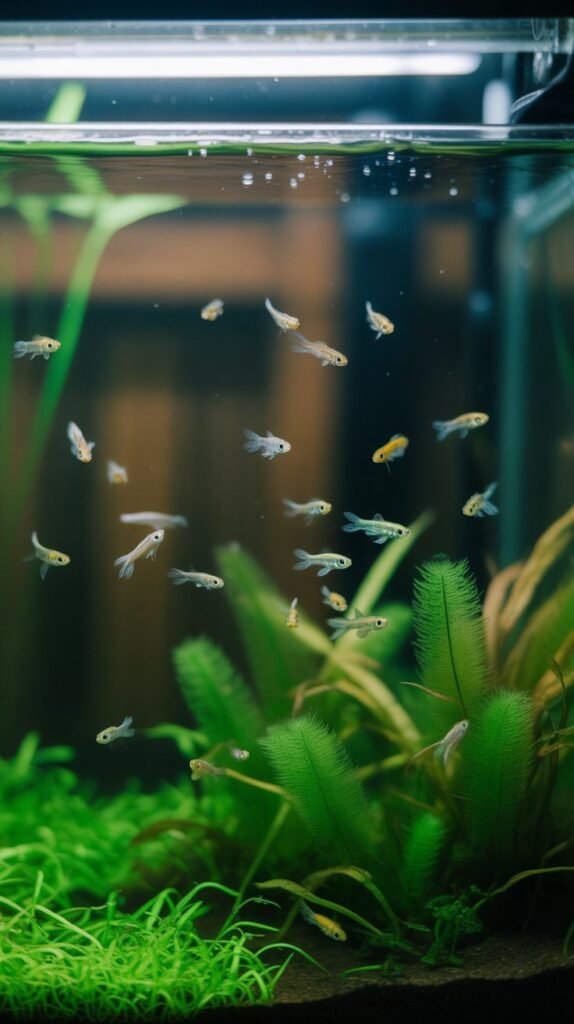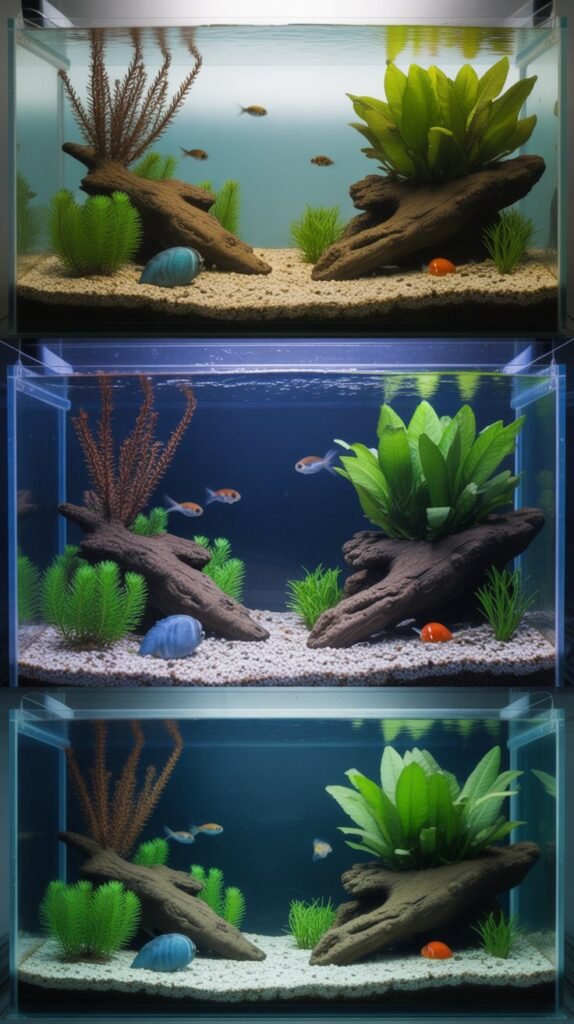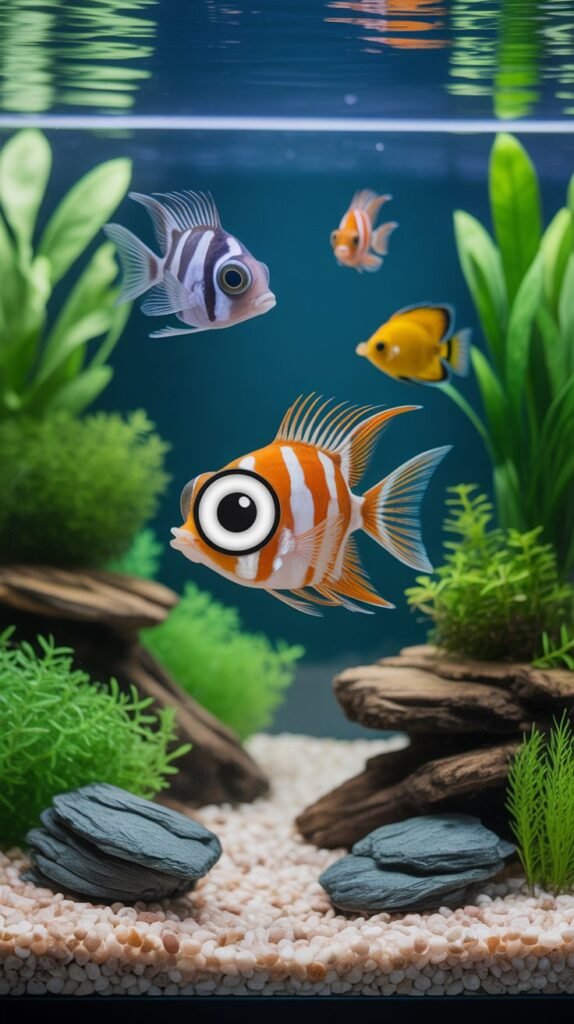Raising baby fish, also known as fry, is one of the most rewarding yet challenging aspects of fishkeeping. To give your fry the best chance at survival, setting up a dedicated aquarium fry tank is essential. A fry tank provides a safe environment, free from predators and harsh conditions, where young fish can grow strong before joining the main aquarium. Whether you are breeding guppies, mollies, tetras, or more delicate species, a properly maintained fry tank can significantly improve survival rates.
In this comprehensive guide, we will explore everything you need to know about aquarium fry tanks: what they are, why they’re important, how to set them up, and how to maintain them effectively.
What is an Aquarium Fry Tank?
An aquarium fry tank is a specialized tank designed to house baby fish (fry) separately from adult fish. Since most adult fish eat their own fry or cannot coexist safely with them, fry tanks act as a protective nursery where fry can grow without the risk of predation. These tanks are usually smaller than display aquariums and are equipped with gentle filtration, proper heating, and suitable hiding spots.

Fry tanks may also serve as breeding tanks, where fish spawn, and eggs hatch before fry are separated for rearing. Depending on the species, fry tanks can be simple setups with sponge filters and live plants or advanced systems with controlled water conditions.
Why Do You Need a Fry Tank?
Many beginner aquarists wonder if they really need a separate fry tank. The answer is yes, especially if you want a higher survival rate. Here are the main reasons why:
1. Protection from Predators
In community aquariums, even the most peaceful species may eat fry. A fry tank ensures that baby fish are safe until they are big enough to survive in the main tank.
2. Controlled Environment
A fry tank allows you to maintain ideal water parameters (temperature, pH, hardness) specifically suited for fry, which may differ from adult requirements.
3. Better Feeding Management
Fry require frequent feedings of specialized foods like infusoria, baby brine shrimp, or powdered fry food. A fry tank prevents competition with adults and ensures fry get the nutrition they need.
4. Easier Observation
Keeping fry in a separate tank makes it easier to monitor their growth, health, and behavior without disturbances from other fish.
5. Increased Survival Rates
Simply put, a dedicated fry tank dramatically increases survival chances compared to leaving fry in a community aquarium.
Choosing the Right Aquarium Fry Tank Size

When selecting a fry tank, size matters. The right size depends on the species and the number of fry you expect.
- Small Species Fry (Guppies, Endlers, Mollies):
A 5 to 10-gallon tank is often sufficient for livebearer fry. - Medium Species Fry (Angelfish, Gouramis, Bettas):
A 10 to 20-gallon tank provides enough space for growth and swimming. - Large Species Fry (Cichlids, Goldfish, Koi):
A 20 to 40-gallon or larger fry tank may be required, depending on the number of fry produced.
Tip: It’s better to start small with a manageable tank size, then upgrade as fry grow larger.
Essential Equipment for a Fry Tank
Setting up an aquarium fry tank requires specific equipment to ensure fry safety and health.
1. Sponge Filter
- A sponge filter is the best filtration system for fry tanks.
- It provides biological filtration while preventing fry from being sucked into the filter.
- Sponge filters also create gentle water currents, which help oxygen circulation without stressing fry.
2. Heater
- Fry are sensitive to temperature fluctuations.
- A reliable aquarium heater ensures stable water temperature, usually between 75–80°F (24–27°C) depending on the species.
3. Air Pump
- If using a sponge filter, an air pump is needed to power it and increase oxygen levels.
- Oxygen-rich water is crucial for fry survival and growth.
4. Lighting
- Moderate aquarium lighting encourages natural behavior and supports plant growth.
- However, fry tanks do not require strong lighting; dim lights often reduce stress.
5. Substrate (Optional)
- Many breeders keep fry tanks bare-bottom for easy cleaning.
- A thin layer of fine gravel or sand can be used but may trap waste.
6. Plants & Hiding Spots
- Live plants like Java moss, Hornwort, or Guppy grass provide hiding spaces for fry and promote infusoria growth (a natural fry food).
- Artificial decorations can also work but live plants are preferable.
7. Cover or Lid
- A tight-fitting lid prevents fry from jumping out and reduces evaporation.
How to Set Up an Aquarium Fry Tank

Follow these steps to set up your fry tank successfully:
Step 1: Choose a Location
- Place the tank in a quiet area, away from direct sunlight and temperature fluctuations.
Step 2: Install Equipment
- Add the sponge filter, heater, and air pump.
- Test all equipment before adding water.
Step 3: Fill with Conditioned Water
- Use dechlorinated water or water from the main aquarium.
- Ensure water parameters match the breeding tank to avoid shock when transferring fry.
Step 4: Add Plants and Hiding Spots
- Add Java moss, floating plants, or breeding mops for fry security.
Step 5: Cycle the Tank
- Allow beneficial bacteria to establish before introducing fry.
- A seeded sponge filter from the main tank can speed up cycling.
Step 6: Transfer Fry
- Once the tank is ready, gently transfer fry using a soft net or siphon.
- Avoid stressing or injuring them during the move.
Feeding Aquarium Fry
Fry require frequent, nutrient-rich meals to grow properly. Different species have different needs, but general feeding guidelines include:
- Newly Hatched Fry (First Few Days):
- Infusoria
- Liquid fry food
- Green water (algae-rich water)
- Young Fry (1–3 Weeks):
- Baby brine shrimp
- Microworms
- Powdered fry food
- Growing Fry (3+ Weeks):
- Crushed flakes
- Daphnia
- High-quality micro pellets
Feed fry small amounts 3–5 times daily. Overfeeding can pollute the tank, so remove uneaten food promptly.
Maintaining a Fry Tank
Maintenance is key to keeping fry healthy. Follow these best practices:
- Regular Water Changes
- Perform 20–30% water changes weekly to keep water clean.
- Use a siphon with a sponge over the tip to avoid sucking fry.
- Monitor Water Parameters
- Maintain stable temperature and pH.
- Test ammonia, nitrite, and nitrate levels regularly.
- Avoid Strong Currents
- Keep water flow gentle. Fry are weak swimmers and can be stressed by strong currents.
- Gradual Tank Cleaning
- Clean glass and substrate gently to avoid harming fry.
- Do not over-clean, as fry need beneficial bacteria for water stability.
Transitioning Fry to the Main Tank
Once fry grow large enough (usually 1–2 months for livebearers, longer for slower-growing species), they can be moved to the main tank. Before transferring:
- Ensure fry are too big to be eaten by adult fish.
- Gradually acclimate them to the main tank’s water conditions.
- Introduce them during feeding time to reduce aggression.
Common Mistakes in Fry Rearing
Avoid these mistakes to ensure maximum fry survival:
- Skipping a fry tank – Most fry won’t survive in a community tank.
- Overfeeding – Leads to poor water quality and fry deaths.
- Strong filtration – Can trap or stress fry.
- Inconsistent water changes – Leads to ammonia spikes.
- Mixing fry sizes – Larger fry may outcompete or eat smaller ones.
Conclusion
An aquarium fry tank is one of the most important tools for successful fish breeding. It provides a controlled, predator-free environment where fry can grow strong and healthy. With proper equipment like sponge filters, heaters, and live plants, alongside careful feeding and maintenance, you can maximize fry survival rates and enjoy the rewarding experience of raising new life in your aquarium.
FAQs About Aquarium Fry Tanks
Q1: How long should fry stay in a fry tank?
Fry should remain in the fry tank until they are large enough not to be eaten by adult fish, usually 4–8 weeks depending on the species.
Q2: Can I use the main aquarium as a fry tank?
Not recommended, as most adults will eat fry. A separate tank or breeding box is safer.
Q3: What is the best filter for a fry tank?
A sponge filter is best because it provides biological filtration without sucking fry into the filter.
Q4: Do fry tanks need heaters?
Yes, fry are sensitive to temperature fluctuations. A heater ensures stable conditions for healthy growth.
Q5: How often should I feed fry?
Feed fry 3–5 times daily in small portions to ensure they grow well without fouling the water.
Q6: Can I keep different species of fry in the same tank?
It’s possible but not recommended, as fry may have different growth rates and dietary needs.
Q7: Is a bare-bottom fry tank better than one with substrate?
Yes, bare-bottom tanks are easier to clean and safer for tiny fry.
Q8: How do I prevent fry deaths in a fry tank?
Maintain stable water parameters, avoid overfeeding, and perform regular water changes.

